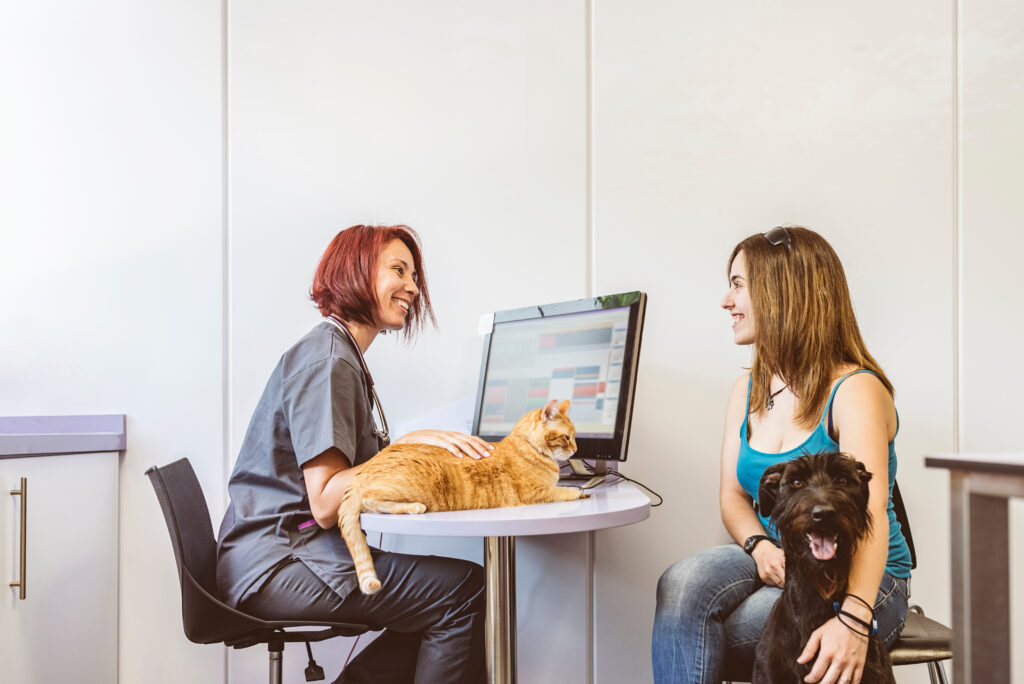Revolutionising Veterinary Front Desks with AI: The Future of Client Engagement
Traditionally, veterinary front-desk teams have been the backbone of clinic operations. Managing phone calls, scheduling appointments, checking in patients, processing payments – the list of responsibilities is extensive. And all of this must be done while ensuring a welcoming environment for both two- and four-legged visitors.
Now, AI technology is transforming veterinary clinic operations, particularly at the front desk. By automating routine tasks, AI frees up staff to focus on high-value client interactions, reducing stress and improving efficiency. AI-powered systems offer 24/7 appointment scheduling, handle basic client inquiries, and even provide personalised communication, ensuring that pet owners receive prompt support when they need it.

This shift is about more than just efficiency – it enhances the client journey while improving the work experience for veterinary teams. In this article, we’ll explore the latest AI-driven solutions for veterinary front desks, focusing on those available in the UK market and how to implement them effectively in your practice.
AI-Powered Appointment Scheduling: Seamless and Stress-Free
AI-driven appointment scheduling systems, such as Vetstoria and Virtual Vet Nurse, and other appointment scheduling tools like Digital Practice and PetsApp streamline the booking process from start to finish. These tools automate scheduling, send reminders, and manage follow-ups without requiring constant human oversight.
- Clients select appointment slots based on real-time availability.
- Automated confirmations and reminders reduce no-shows and last-minute cancellations.
- AI can adjust availability dynamically, accounting for emergencies or changes in scheduling.
For practices experiencing high call volumes, these solutions ensure clients can book appointments quickly and efficiently, without waiting on hold.
AI Call Agents: The Future of Phone Bookings
AI call agents are revolutionising veterinary communication. Using advanced natural language processing (NLP), these AI-driven assistants conduct phone conversations that feel remarkably human. Great examples of these are PetsApp and Lupa’s conversational AI. Beyond appointment scheduling, AI call agents can:
- Provide essential practice information (hours, services, location).
- Answer frequently asked pet care questions.
- Route complex inquiries to the appropriate team members.
- Send confirmation texts or emails after calls.
Enhancing Client Communication with AI
AI-assisted tools, like PetsApp, Copilot and Gemini, improve client engagement by providing:
- Personalised Messaging: AI analyses client history and pet data to generate tailored communications.
- Consistent Tone and Branding: Ensures all client interactions reflect the practice’s brand voice.
- Time-Saving Automation: AI drafts responses, allowing staff to approve or tweak messages before sending.
- Multi-Channel Support: AI-powered messaging spans email, SMS, and app-based chat.
This combination of AI and human oversight enhances communication while maintaining a personalised approach.
24/7 Chatbots and Virtual Assistants: Instant Support for Clients
AI chatbots and virtual assistants provide instant responses to client inquiries via websites or mobile apps. Tools such as Vidivet and Virtual Vet are great examples of how these tools can assist you in practice. These tools use NLP to understand client concerns and provide relevant information. For instance:
- Practice Information: Instantly provides details on opening hours, services, and policies.
- Appointment Requests: Offers real-time availability and scheduling options.
- Symptom Triage: Directs clients to appropriate care pathways based on reported symptoms.
Implementing AI Solutions: A Practical Guide
AI adoption is a game-changer, but successful implementation requires planning. Here’s how to introduce AI to your veterinary practice:
1. Identify Your Needs
Assess current challenges – whether it’s high call volumes, appointment scheduling bottlenecks, or inconsistent client communication. Identify which AI solutions align with your specific operational needs.
2. Research and Test AI Tools
Explore available AI solutions, ensuring they integrate with your existing practice management software. Focus on UK-compatible platforms and request demos or trial periods to evaluate functionality before committing.
3. Get Your Team Onboard
Staff buy-in is crucial. Educate your team on AI benefits, address concerns about job security, and provide hands-on training to ensure smooth adoption.
4. Plan a Phased Rollout
Introduce AI gradually to avoid disruption. Start with one feature – like AI scheduling – before expanding to AI call agents or chatbots.
5. Customise for Your Practice
Tailor AI tools to match your practice’s voice and workflow. This includes chatbot responses, appointment booking settings, and messaging preferences.
6. Communicate with Clients
Announce AI-powered enhancements through newsletters, social media, and signage in your practice. Highlight how AI improves their experience while reassuring them that human support remains available.
7. Prioritise Data Security
Ensure AI solutions comply with UK data protection regulations (such as GDPR). Implement robust security measures and conduct regular audits to maintain compliance.
8. Monitor Performance and Adapt
Regularly review AI effectiveness – track client satisfaction, operational efficiency, and staff feedback. Adjust as needed to optimise performance.
Embracing AI for a More Efficient and Client-Centric Practice
AI isn’t replacing the human touch – it’s enhancing it. By integrating AI-powered solutions, veterinary practices can improve efficiency, reduce staff workload, and provide seamless, high-quality client experiences. As pet owner expectations continue to evolve, embracing AI ensures that veterinary teams remain at the forefront of innovation while maintaining the compassion and care that define the profession.
Are you ready to modernise your front desk with AI? Start small, experiment with different tools, and watch how automation transforms your practice for the better.